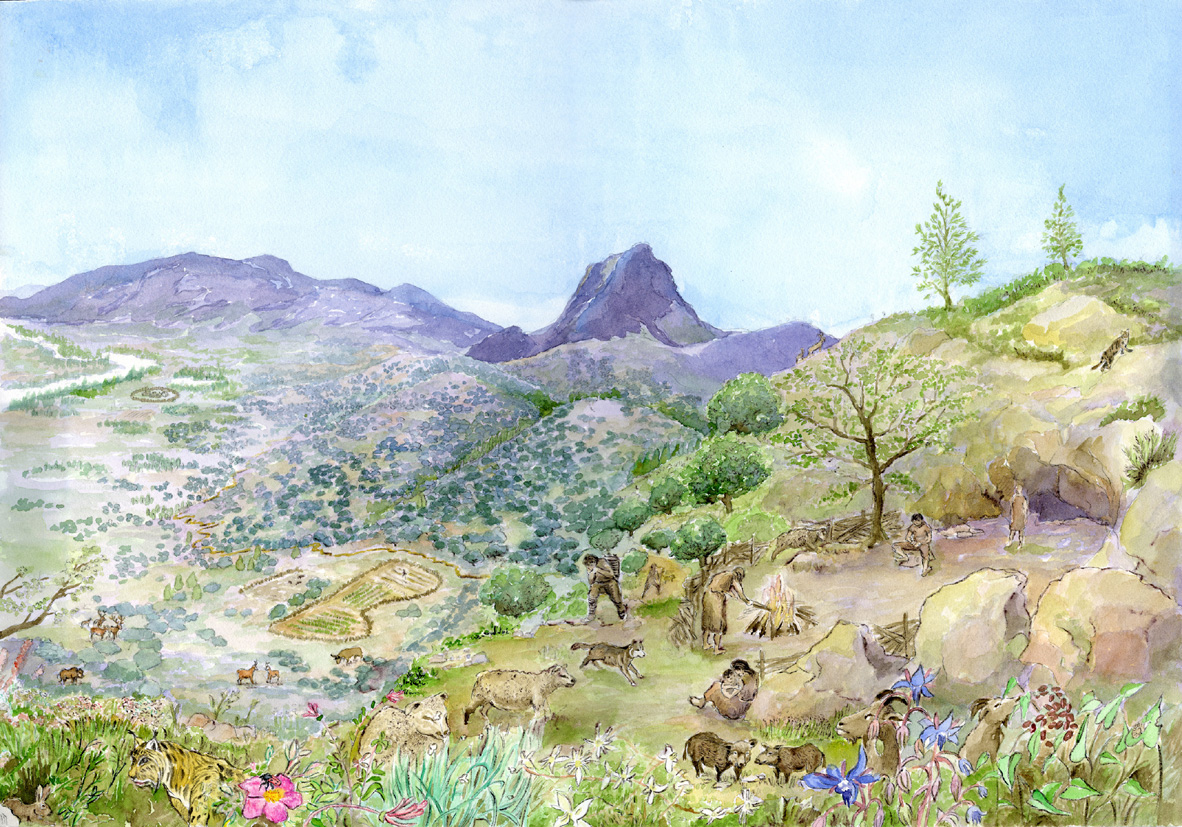Cova de L’Or
THE TIME OF THE FIRST FARMER AND SHEPHERD
Excavation campaigns
The Cova d’Or opens on the southern slope of the Benicadell mountain range, dominating the valley of the river of Alcoy. It is a cave with excellent living conditions that welcomed one of the groups of farmers and pioneering breeders of Mediterranean origin that expanded through our lands since the middle of the 6th millennium BC (5600 BC).
The first news as an archeological site are from 1933, when R. Pardo made some tastings. Explored again by the Museum of Alcoy, in 1955 the excavation campaigns of the Prehistoric Research Service of the Diputación of Valencia began, in front of which they were J. San Valero and V. Pascual, who would continue them from 1956 to 1958 .
 The wealth and importance of the deposit, especially its ceramics decorated by the impression of the edge of a Cardium shell, quickly became a key to the Neolithic Valencian research. The charred cereals were dated by the C14 method, with results reaching the date of 5550 BC, establishing the initial horizon of agriculture and livestock in the Iberian peninsula.
The wealth and importance of the deposit, especially its ceramics decorated by the impression of the edge of a Cardium shell, quickly became a key to the Neolithic Valencian research. The charred cereals were dated by the C14 method, with results reaching the date of 5550 BC, establishing the initial horizon of agriculture and livestock in the Iberian peninsula.
 New excavation campaigns and interdisciplinary research were resumed in 1975 by the SIP, now under the direction of V. Pascual and B. Martí until 1985.
New excavation campaigns and interdisciplinary research were resumed in 1975 by the SIP, now under the direction of V. Pascual and B. Martí until 1985.
THE COTIDIAN LIFE IN EL COVA DE L’OR
When the first Neolithic groups arrive at the Perputxent Valley, the climax has reached the temperature and humidity of the Atlantic period. Some conditions that enhanced the splendor of the Mediterranean forest of holm oaks, coconuts and strawberries, intermingled with deciduous trees such as quejigos, maples, ashs, cherry trees and thorns. In the solarium of Benicadell the warmest species such as the holly and the lens would be protected, or the most frugal like white pine, rosemary and jaras.
Towards the 5600 BC, this landscape begins to undergo a profound transformation and the Cave of Gold tells us about the footprint of human groups. The productive activities of the neolithic societies will reduce the forest to implant pastures and fields of culture. Charcoal remains show the cultivation of cereals such as wheat and barley, and legumes such as beans, lentils or peas. Regarding domestic animals, the predominance of sheep is very striking, with a small number of goats. The pig is well represented and scarcely the bull and the dog.
The farmer’s way of life requires the manufacture of a new domestic wardrobe, of which the ceramic vessels used to cook and store are part. The flint leaves are used as knives, or as elements of sickle. Polishing axes serve for wood work. And bone spoons confirm the changes in food habits, now based on cereals and legumes.
CERAMICS, ART AND RELIGION.

 Agriculture begins to develop in the Near East since the tenth millennium BC. With that distant origin the Neolithic communities are expanding and, through the Anatolia Peninsula, extend through the Balkans and the banks of the Aegean Sea well advanced in the seventh millennium. They are small communities that live in villages of ten cabins and that, as the number of families that make up them, they occupy new territories.
Agriculture begins to develop in the Near East since the tenth millennium BC. With that distant origin the Neolithic communities are expanding and, through the Anatolia Peninsula, extend through the Balkans and the banks of the Aegean Sea well advanced in the seventh millennium. They are small communities that live in villages of ten cabins and that, as the number of families that make up them, they occupy new territories.In the lands of the Mediterranean West these Neolithic groups receive the name of Culture of Printed Ceramics, according to the decoration of their glasses made by the impression of the Cardium shell. The recent research on the Golden Cave has made it possible to determine that the rich decoration of printed ceramics contains a broad repertoire of anthropomorphic motifs that are related to rock paintings, particularly those of the shelters of the Pla de Petracos in Castell de Castells and of the Sarga in Alcoy. That confirms that the first Neolithic communities were the authors of those cave paintings and, according to the central theme of the human figure with raised arms, the paintings and vessels would have a religious purpose.
SCHEDULE OF VISITS
concerted visits
Phone: 965 51 50 35/965 51 50 59
Text and coordination
Bernat Martí Oliver
Beniarrés Town Hall and MARQ
with the collaboration of
Museum of Prehistory of Valencia and Municipal Archaeological Museum of Alcoy
Location on the map




